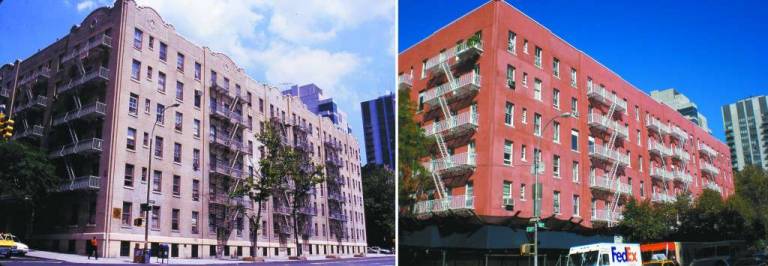Undermining Landmark Status?

Owners of the City and Suburban apartments on the Upper East Side want to demolish the buildings
The two pink stucco buildings on 429 E. 64th St. and 430 E. 65th St. and York Avenue may not look like much architecturally, but they are landmarked buildings, designed by Philip H. Ohm as the first light court tenement structures in the city - low-income buildings designed to address the dark and dank living conditions for immigrants of the early 20th century. Apartments have windows facing courtyard. The average price for an apartment at 371 square feet is $600 per month.
Because of their historic significance, community members are desperately trying to save these buildings from being de-landmarked and demolished.
City and Suburban Homes Company built them in 1914-15.
Last week, the Landmarks Preservation Commission held a hearing to determine whether Stahl Real Estate, who owns the properties, can claim hardship in the upkeep and rental of the buildings. If their claim is approved, the building can be de-landmarked and Stahl will tear down the buildings to put up luxury condominiums. More than 20 people and groups testified at the hearing, from residents at City and Suburban, to Friends of the Upper East Side Historic Districts - the land marking group that leads the fight against Stahl, Assembly Member Micah Kellner and Sen. Liz Kreuger.
"Since 1898, these buildings have provided safe, affordable shelter for hundreds of families and were and are today, a cohesive community," testified Jeanne Scott-Monck, a resident of 429 East 64th St. "Whatever the perceived hardship the owners of the building are claiming, is self-inflicted and they can cure it."
Many of the residents and community members spoke of this same issue with Stahl's hardship application.
But Brian Maddox, a representative from Stahl Real Estate said that 124 out of the 190 units are vacant. Ninety-seven of these units, said Maddox were voluntarily surrendered. Stahl hired Cushman and Wakefield, an advisory firm, and they determined that pre-war six-floor walkups can be rented out anywhere from $600-$800 per month with a $4 million renovation, or for $1,235 with a $17 million dollar renovation.
"It's an economic argument that the rents that could be attained aren't sufficient to meet operating and owning expenses," said Maddox. "Tenants were giving them up at that rent which tells you that they aren't attractive enough even at a cheaper rent. I think Cushman and Wakefield makes it clear that economically they are a challenge whether occupied or not."
Friends of the Upper East Side disputes this argument. Liz Kelly, a representative from Friends of the Upper East Side, said that if they are marketed correctly and are kept up well, these apartments can be rented out at a much higher rate. Tara Kelly said that their analysis, conducted by HR and A, found that with a 5 percent vacancy rate, Stahl can rent the units out for an average of $1,500 per month.
"They are keeping the apartments vacant so that they can take down the building," said Kelly. "Historic vacancy levels in all of New York are below 2 percent, but yet they can't rent out their spaces. They said they've been making an effort, but there's no marketing and the leasing office is closed half of the time."
In fact, community members have been fighting this for several years. Stahl acquired the two buildings in 1974. In 1990, Landmarks designated the entire block as landmarked buildings, but just before the status was about to go into effect, landmarks overturned it, to compromise between developers and landmark enthusiasts.
In 2006, Stahl made significant changes to the building, including removing the façade and replacing it with the unremarkable pink stucco exterior seen today on City and Suburban. Shortly thereafter, the buildings were landmarked due to historic, as opposed to architectural significance. In 2011, Stahl sued the city to be able to tear down the buildings on the basis of economic hardship.
"These two buildings are an essential part of New York's history and must be preserved," said Assembly Member Micah Kellner in his testimony. "Given the absurdity of the owners' conclusions, LPC has no other choice than to deny their application."
But for Stahl Real Estate, this issue is much more complicated than it may seem. He said that Friends of the Upper East Side's consulting analysis makes little sense, because it assumes asking rents as opposed to average rents, and other features like marble bathrooms and new appliances.
"Indiscriminate landmarking is not necessarily always a good thing," said Brian Maddox. "We have been very respectful of landmarked buildings, but in this case we want to demolish the building and replace it with improved structures - giving the people who are displaced, bigger apartments with comparable rents, and giving the neighborhood something more attractive."
Landmarks has yet to set a date for the final vote.